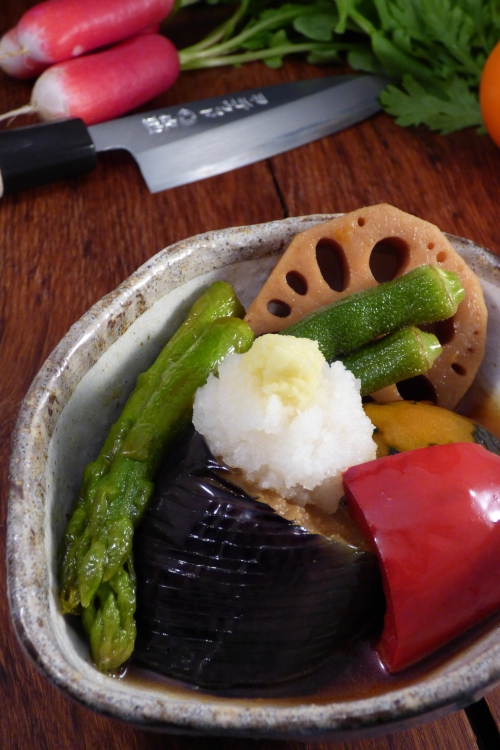Every now and then you come across a side dish so vibrant, flavoursome and bountiful that it could be- and often is in our household- a main meal in itself. Yasai no Agebitashi, or ‘fried and soaked vegetables’ to translate its name, is one such dish. Nearly always made with aubergine as the main ingredient, a selection of firm vegetables are deep fried quickly without any form of coating, ‘suage’ style. The fierce heat of the oil causes the insides of the vegetables to steam through before they get marinated in a sweetened dashi broth; the tender, cooked vegetables absorb the liquid like a sponge, carrying the flavour throughout. This technique creates silky, creamy aubergines that melt in your mouth, while crisper vegetables like the lotus root and red peppers retain just the right amount of bite, providing a fantastic contrast of textures. Topped off with a spicy mound of grated daikon and ginger to counter the richness of the vegetables and the sweetness of the broth, this is the perfect appetiser or side dish to go with nearly any meal, and by changing the dashi to a kombu broth you can easily make a vegan or vegetarian version.

Ingredients.
- 500ml dashi
- 25g sugar
- 75ml soy sauce
- 40ml mirin
- half a large aubergine (around 150g)
- one small section lotus root (around 100g)
- 150g piece of kabocha
- one medium red pepper (around 150g)
- 100g asparagus
- 100g okra
- vegetable oil for deep frying
- 5cm piece of daikon
- thumb-sized piece of ginger
- Pour the dashi, soy sauce and mirin into a saucepan and bring to a simmer over a medium heat, add the sugar and stir well. When the broth has returned to a simmer and the sugar has completely dissolved, put a lid on the pan and take off the heat; set aside for later.
- Peel and slice the lotus root into 1cm thick slices, cut the asparagus stalks into three pieces and slice each okra in half lengthways. Deseed the red pepper and cut it into eighths, roughly peel the kabocha, remove the seeds and cut it into pieces about 3cm thick. Using a sharp knife, make a series of shallow incisions about 2-3mm apart into the skin of the aubergine, you don’t want to cut all of the way through, just to about a third or half of the depth of the flesh. Once you’ve made these cuts, chop the aubergine into four pieces along the length.
- Place your vegetable oil in a deep saucepan on a medium heat, then slowly warm the oil until it reaches around 160-170ºC. Once at temperature, add your aubergine pieces with their skin side facing down, fry them for three or four minutes until they just start to colour on the edges, then remove them and place on a wire rack to cool. Repeat this process for the kabocha and the lotus root slices, watching the lotus carefully as it can change from pale white to deep brown very quickly. Finally fry the red peppers, okra and asparagus for no more than two minutes before removing them to drain. The vegetables will still be slightly firm at this point, but the residual heat from the frying will continue the cooking process for a few minutes longer.
- When all of your vegetables have been fried, pat off any excess oil with some kitchen roll and arrange them in the bottom of a wide, flat bottomed bowl before carefully pouring the dashi broth over the top of them. Leave the vegetables soaking in the warm liquid for at least an hour so they can absorb plenty of flavour and let the crisped edges plump back up. You can leave the mixed vegetables in this marinade for a day or two in the refrigerator if you want before moving onto the final step. If you do this, take them out of the fridge for a couple of hours prior to serving, allowing them to come to room temperature.
- Arrange the vegetables in your serving bowls, making sure to spoon over plenty of the liquid. Peel the daikon and ginger, then grate each of them to a pulp; this is a lot easier on a Japanese oroshigane style grater but the fine side of a standard box-grater will work well too. Top the agebitashi with a mound of grated daikon and a smear of ginger just before serving.
Serves 4 people as a side dish or appetiser.